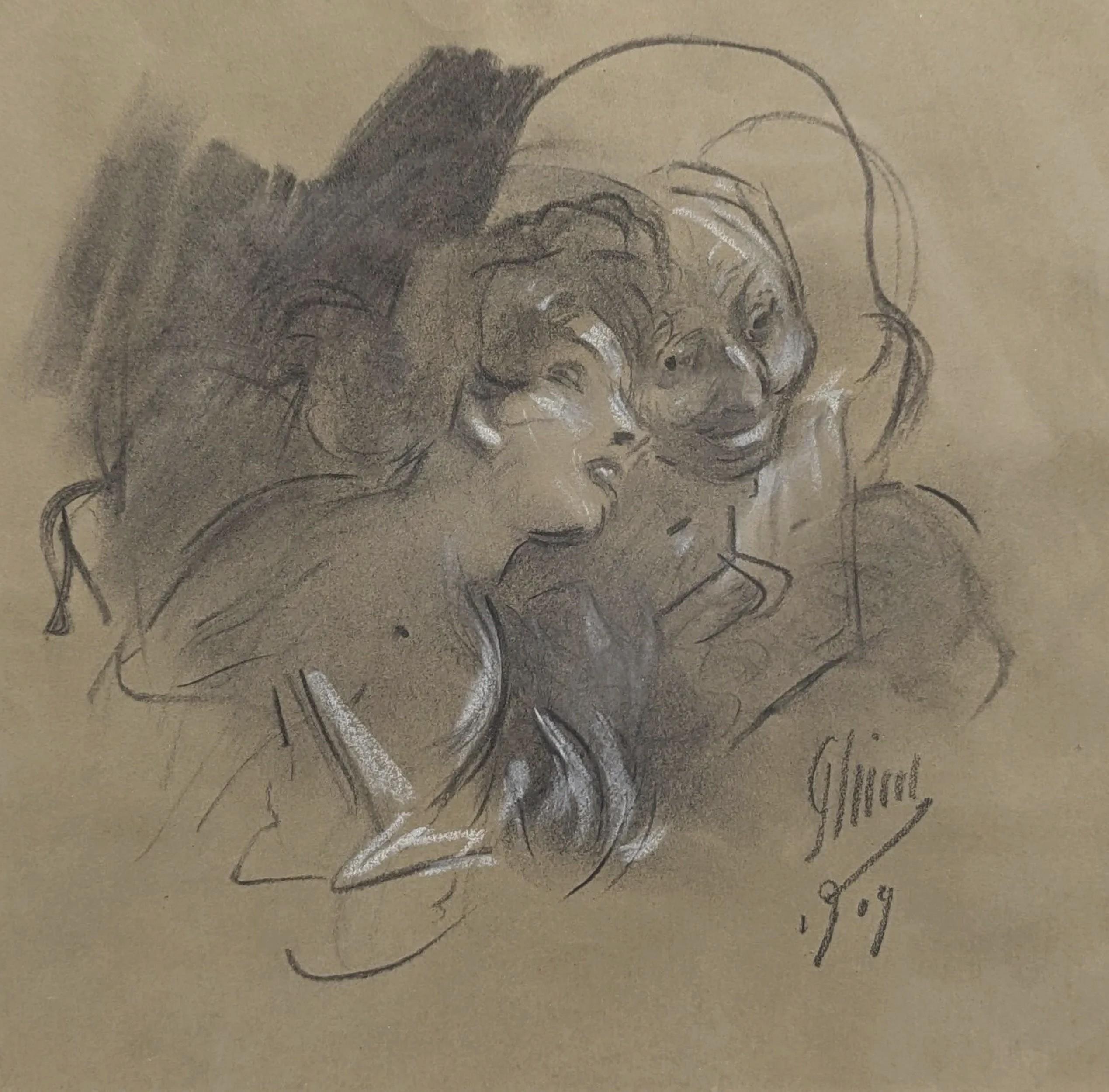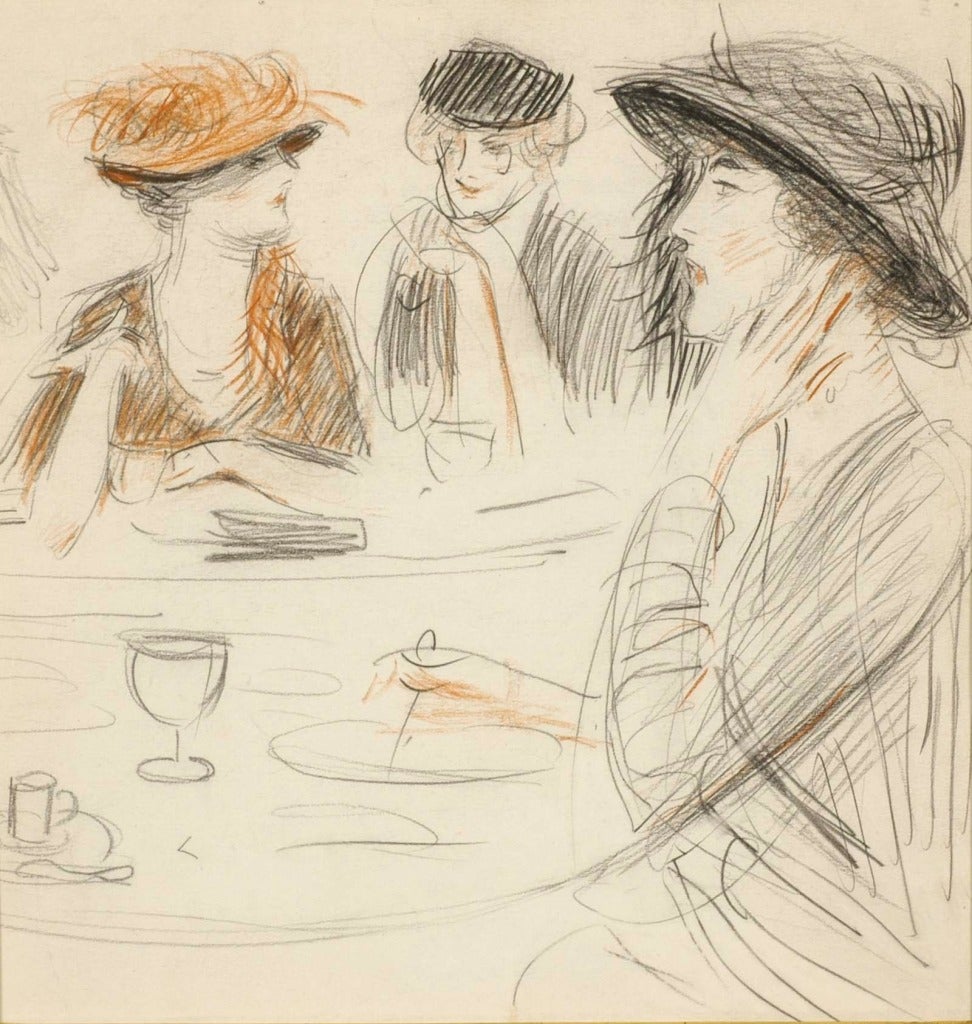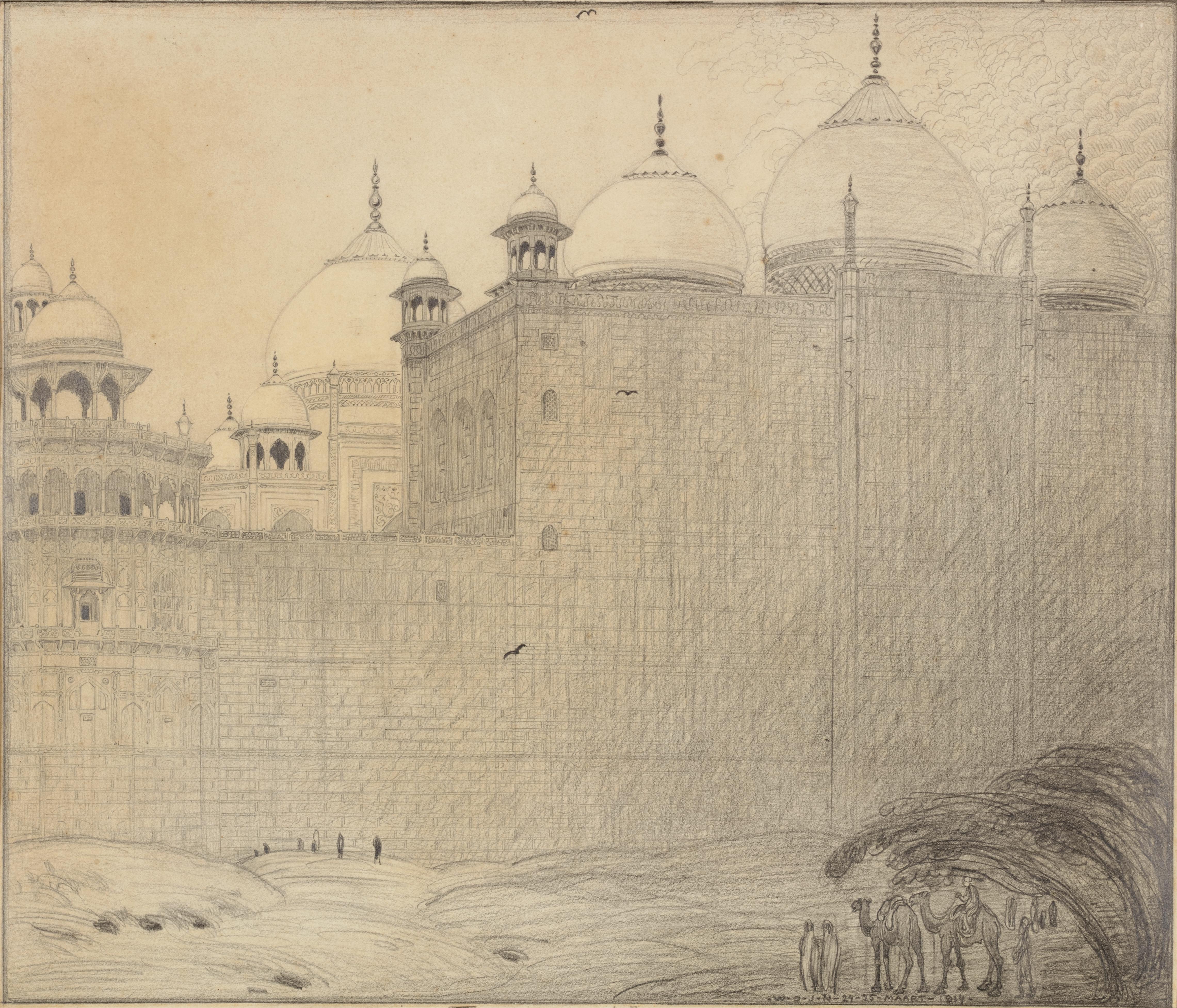Jules ChéretJules Cheret (1836-1932) A couple, 1909, drawing signed 1909
1909
About the Item
- Creator:Jules Chéret (1836 - 1932, French)
- Creation Year:1909
- Dimensions:Height: 9.06 in (23 cm)Width: 9.06 in (23 cm)
- Medium:
- Movement & Style:
- Period:
- Condition:
- Gallery Location:Paris, FR
- Reference Number:
Jules Chéret
Once upon a belle époque, Jules Chéret and his posters were the toast of Paris. It was the Art Nouveau era, a time when works like those created by Chéret were key to the fabric of the cosmopolitan thoroughfare in the French capital. Today, this extraordinary artist and printer is little known.
It was Chéret who transformed the street advert into the most expressive and coveted art form of the late 1800s. Think: a red-headed belle in a flimsy yellow dress, frolicking through a field of blue as she pours a glass of “tonic wine,” with the brand name Vin Mariani wafting about her.
Through his bold advances in chromolithography and the graphic arts, Chéret and the younger talents he inspired — like Pierre Bonnard, Alphonse Mucha and Henri de Toulouse-Lautrec — along with other artists, turned the stone-gray streets of Paris into a kaleidoscopic, ever-changing urban spectacle.
Raised in a family of poor Parisian artisans, Jules Chéret was apprenticed to a lithographer at 13. Although he took a class at the École nationale de dessin, as an artist, he was largely self-taught, schooling himself in art history and technique by visiting remarkable works at museums. When his first solo poster designs failed to garner further commissions, Chéret, then 23, relocated to London, where colorful but text-heavy posters enlivened the streets.
The move proved pivotal, as he soon found work with the French expat Eugène Rimmel, a visionary businessman and one of the founders of the beauty and healthcare industries. A brilliant marketer, he regularly produced colorful, elegantly illustrated and culturally sophisticated catalogues to publicize House of Rimmel cosmetics and fragrances. These and other promotional ventures kept Chéret busy, while sharpening his understanding of the commercial potential of print.
So, when he learned of the invention of a press that could print large-scale formats inexpensively, Chéret recognized an opportunity to become his own boss. Now 30 years old, he returned to Paris with the financial support of Rimmel to establish his own print shop specializing in jumbo-size street posters and set about forging a fresh, eye-catching approach to their design.
Chéret accelerated the process of chromolithography by adding a stone with a graduated background that scaled in hue from orange to blue. With this, in addition to red- and black-pigmented stones, he could make vibrant posters more quickly and cheaply. In the late 1870s, his acquisition of steam-powered presses further sped up production and dramatically increased the volume of his output.
But perhaps Chéret’s greatest contribution to our world today was a simple insight into an eternal truth: Sex sells. The best way to market a product is to put a pretty, revealingly dressed young woman in the ad. In the 1890s, Chéret put so many to work in this cause that they came to be known as “Chérettes,” a conflation of chérie (“darling”) and Chéret.
Descended from the enchanting mademoiselles in the bucolic painterly confections of Rococo artists like Antoine Watteau and Jean-Honoré Fragonard, all smiles and femininity, they fused the present with the past, making them potent symbols of a newly affluent and peaceful France.
Find original Jules Chéret posters and prints and other Art Nouveau posters on 1stDibs.
- ShippingRetrieving quote...Ships From: Paris, France
- Return PolicyA return for this item may be initiated within 14 days of delivery.
- Jules Cheret (1836-1932) La Confidence, 1909, drawing signedBy Jules ChéretLocated in Paris, FRJules Cheret (1836-1932) La Confidence (The confidence) 1909 signed and dated in the lower right Charcoal and heightenings of white chalk 22.7 x 22.7 cm Framed under glass : 33.8 x...Category
Early 1900s Art Nouveau Figurative Drawings and Watercolors
MaterialsChalk, Charcoal
- Jules Cheret (1836-1932) Three studies of women, original signed drawingBy Jules ChéretLocated in Paris, FRJules Cheret (1836-1932) Three studies of women charcoal on paper signed on the bottom left 39 x 24.5 cm This drawing of studies was part of the artist's workshop as so it bears the...Category
1910s Art Nouveau Figurative Drawings and Watercolors
MaterialsCharcoal
- Jules Cheret (1836-1932) Two studies of a woman, 1921 charcoal drawing, signedBy Jules ChéretLocated in Paris, FRJules Cheret (1836-1932) Two studies of a woman, 1921 charcoal on grey paper signed and dated 24 10 (19)21 on the bottom right 39.5 x 24 cm A varnish stain in the lower middle of t...Category
1920s Art Nouveau Figurative Drawings and Watercolors
MaterialsCharcoal
- Lucien Victor Guirand de Scevola (1871-1950), Les Marionnettes 1910, drawingBy Lucien-Victor Guirand de ScévolaLocated in Paris, FRLucien Victor Guirand de Scevola (1871-1950) Portrait of Marie-Thérèse Piérat in Les Marionnettes, 1910 Pencil on paper, signed, dated and annotated lower ...Category
1910s Art Nouveau Portrait Drawings and Watercolors
MaterialsCarbon Pencil
- Felician Myrbach (1853-1940) Poèmes magyarsBy Felician MyrbachLocated in Paris, FRFelician Myrbach (1853-1940) Poèmes magyars, Magyar poems bears the monogram "M" on the lower left, titled in the upper right Ink on paper 29,8 x 19,8 cm in good condition, the sheet is slightly yellowed In a modern frame : 33 x 23 cm This is an illustration project by Felician Myrbach for François Coppée's work, "Poèmes magyars". He leaves the space to be occupied by the text blank on the sheet and arranges his composition accordingly. It is interesting to see the artist imagine his drawing with this constraint. Felician Myrbach (also Felicien de Myrbach, Felician von Myrbach, from 1919 Freiherr von Rheinfeld) was born on 9 February 1853 in Zalishchyky, he died 14 January 1940 in Klagenfurt He was an Austrian painter, graphic designer and illustrator. He was a founding member of the Vienna Secession and the director of the Applied Arts School in Vienna (now the University of Applied Arts Vienna), and was instrumental in the creation of the Wiener Werkstätte. Myrbach's father was Franz Myrbach (1818–1882), the Administrator of Bukovina in 1865–70. His older brother Franz Xaver (1850–1919) was an economist and professor at the University of Innsbruck. He attended the Theresian Military Academy in 1868–71, graduating as a Leutnant, then at the Academy of Fine Arts, Vienna under August Eisenmenger. In 1875, he joined the 19th Feldjäger Battalion, and in 1877 became an Oberleutnant in the Military Geographic Institute, then, after campaigning in Bosnia in 1878, he taught drawing at the Infantry Cadet School in Vienna. He continued his artistic studies under C R Huber. In 1881, he went on military leave and moved to Paris, retiring totally from the military in 1884 as a Hauptmann, 2nd Class. He stayed in Paris until 1897, working as an illustrator, including illustrating the works of Alphonse Daudet, Victor Hugo and Jules Verne. Myrbach was a founding member of the Vienna Secession in 1897. In the same year, he became the a professor of the Applied Arts School at the Museum of Art and Industry; Arthur von Scala, another reformer Modernist, was made head of the Museum. In 1889, Myrbach became the director of the school. He brought an enthusiastic Modernist attitude and encouraged an integration between art, design and production. He added Koloman Moser and Josef Hoffmann to the staff, amongst other Secession artists. This would lead to the foundation of the Wiener Werkstätte in 1903. Myrbach leant more towards an aesthetic approach than von Scala, but both worked together to bring about their combined vision of successful, popular Austrian applied art. Myrbach was a voice for reform towards Modernist ideals in the School, which was started 1899 with the support of Alfred Roller, and completed by 1901.The reform of the school has been described as his "lasting merit". Ludwig Hevesi called Myrbach "probably the best [illustrator] in Vienna", partially for his work (with Moser) in the Secession magazine Ver Sacrum. Myrbach visited America on a state-funded study trip in 1904, part of which was to represent the Applied Arts School at the 1904 World...Category
Early 1900s Art Nouveau Figurative Drawings and Watercolors
MaterialsInk
- Felician Myrbach (1853-1940) The Musketeers, original drawingBy Felician MyrbachLocated in Paris, FRFelician Myrbach (1853-1940) The Musketeers bears the monogram "M" on the lower left Ink and pencil on paper 26,7 x 23,7 cm in good condition, In a mod...Category
1890s Art Nouveau Figurative Drawings and Watercolors
MaterialsInk
- Frank Brangwyn Painting Mural Study Christ's Hospital West Horsham England 1912By Sir Frank BrangwynLocated in Portland, ORFRANK BRANGWYN ( U.S./U.K./Belgium, 1867-1956) watercolor, gouache, and charcoal on paper, "The Scourging of St. Alban," study for the mural painted for Christ's Hospital, West Horsh...Category
1910s Art Nouveau Figurative Paintings
MaterialsChalk, Charcoal, Watercolor, Gouache, Pencil
- Entrance to the temple at Klungkung, Bali, 1925Located in Amsterdam, NLEntrance to the temple at Klungkung, Bali, 1925 With studio seal at the reverse, dated and described, bottom left Black chalk on paper, 53 x 46.5 cm In ebonized frame with white mount Willem Otto Wijnand Nieuwenkamp (1874-1950) Nieuwenkamp was born on July 27th 1874 in Amsterdam. His father owned sailing ships sailing to Indonesia and hearing the stories of the returning captains evoked in the young Nieuwenkamp an obsession for distant lands and adventure. After a failed attempt by his father to have his son make a career in his business, Nieuwenkamp attended the Academy for Decorative Art in Amsterdam. However, he left within one year to go his own way. He was an autodidact and a great experimenter with new techniques, particularly in the art of etching. Nieuwenkamp was a very focused man with the discipline of a scientist tempered by the sensitivity of an artist, a lust for adventure, a natural appreciation for ethnic arts and an enormous ambition to tread new paths. In 1898 he visited Indonesia for the first time and on his second visit in 1903-1904 he went on to Bali and became the first foreign artist to love Bali and the Balinese with a passion. Having secured agreements with several museums in the Netherlands to obtain Balinese art...Category
1920s Art Nouveau Landscape Drawings and Watercolors
MaterialsPaper, Chalk
- Tea at the Ritz, New YorkBy Paul César HelleuLocated in Fairlawn, OHTea at the Ritz, New York Colored chalk, 1912 Signed with the estate stamp verso. (see photo) Authenticated by the artist's daughter, Mme Paulette Johnston. Image size: 10 5/8 x 10 1...Category
1920s Art Nouveau Drawings and Watercolor Paintings
MaterialsChalk
- Part of the ring-wall of the Taj Mahal, Agra, India, 1914Located in Amsterdam, NLPart of the ring-wall of the Taj Mahal, Agra, India, 1914 Signed with initials and dated bottom right Black chalk on paper, 45.5 x 53 cm Literature: Ernst Braches en J.F. Heijbro...Category
1910s Art Nouveau Landscape Drawings and Watercolors
MaterialsChalk, Paper
- Untitled Nude Male Diptych, Charcoal/ Graphite on Parchment by Henrik KóborLocated in New York, NYThis refined art nouveau diptych was realized in Hungary in 1908/1909 by the famed artist of the Austro-Hungarian artist Henrik Kóbor. It features two rectangular panels each offerin...Category
Early 1900s Art Nouveau Nude Drawings and Watercolors
MaterialsParchment Paper, Charcoal, Graphite
- Plunder at the Jewish Ghetto, Chalk and Charcoal 'Progrom' DrawingBy Victor E. PenneyLocated in Surfside, FLChalk and charcoal drawing, depicting old world progrom, "Plunder at the Jewish Ghetto, Jews of Frankfurt are attacked in the 16th century."Category
20th Century Modern Figurative Drawings and Watercolors
MaterialsPaper, Chalk, Charcoal






